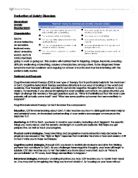Luke Hopson - Psychology of Sports Participation
Anxiety positively affects performance
In the past, anxiety has been defined as “an expression of an individual's personality” (Singer, 1975, p105). This may appear to some people as a very vague representation; however it may prove not to be that bad after all. Everybody becomes anxious from time to time, but the way we interpret this anxiety varies from person to person depending on several factors linked to personality. Some people may say that a more accurate and up to date definition would be that anxiety “is a negative emotional state characterised by nervousness, worry and apprehension” (Weinberg & Gould, 2003, p79). This is a far more concise illustration, yet it clearly states that anxiety is a ‘negative’ factor, while it has also been proven to produce positive outcomes. Anxiety is only negative when individual perceives it as being negative.
The level of anxiety in a situation relates to the amount of stress involved, skill level and the nature of the activity. For example, performers may gain anxiety from the crowd or opponents they fear, if their mind focuses on this, or they may simply just not feel like taking part in the event. State anxiety refers to this “ever-changing mood component” (Weinberg et al 2003, p79). These components could be for example state of mind on day, environment, situation, or the weather. All these factors will play a key role in the way that we interpret our anxiety. In the Journal ‘Anxiety and the Ironman’ by Hammermeister and Burton, they talk about an experiment where they tested the anxiety levels of triathletes. Through this they found out that anxiety was interpreted in several different ways. For example, some triathletes saw the excruciating events as a “tremendous challenge”, whereas others perceived it as a “threatening experience”. This underlines my point that anxiety is not necessarily a bad thing and that it is only negative when we recognise it as a negative factor. In separate experiments in 1965 and 1967, Epstein and Fenz studied the correlation between novices and professionals. They used 33 beginners, and 33 experienced parachute jumpers and tested their anxiety levels from a week before the jumps. They found that the novices apprehension gradually built up throughout the week reaching its optimum seconds before the jump, whereas the professionals portrayed their biggest amount of anxiety on the morning of the jump and this decreased until the event. This indicated to me that “high arousal is experienced as pleasant excitement” (Kerr, 1997), within elite performers and that cognitive anxiety is reduced when you are experienced in your field. In 1990, Martens, Vealey and Burton came in with the competitive state anxiety in inventory-2 (CSAI-2) to differentiate between cognitive and somatic components of state anxiety. It has been proven to be the most accurate and reliable sports anxiety theory to date as it found out that cognitive anxiety remained stable prior to competition while somatic anxiety increased significantly just before the event. Notice this is similar to the way the experienced parachute jumpers handled their anxiety in the test by Epstein et al. The point I'm attempting to get across is that it is the way a performer can turn a negative into a positive, just by their state of mind.







